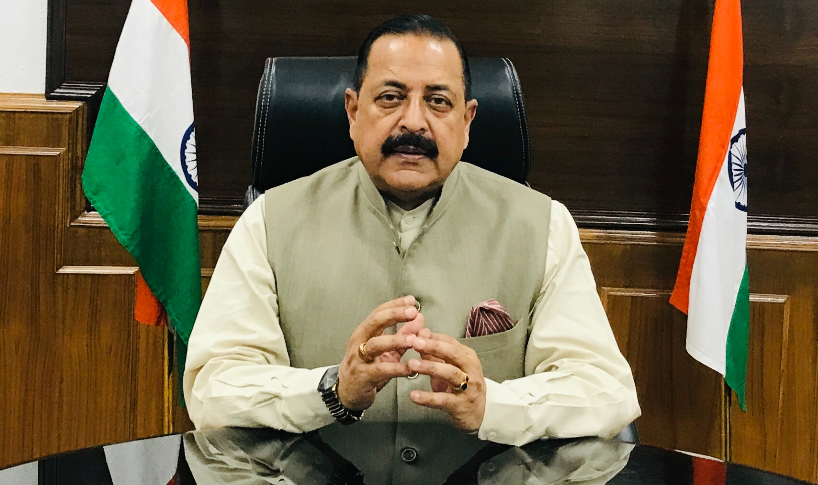NEW DELHI, November 6 : Expressing serious concern over Delhi’s air quality remaining in the ‘severe’ category for the fifth day in a row, forcing closure of primary schools, Union Minister of State (Independent Charge) Science & Technology; Minister of State (Independent Charge) Earth Sciences, Dr Jitendra Singh cautioned that air pollution related stubble burning cases have gone up by 120% in Rajasthan and 20% in Punjab respectively. This, he said, implies that the governments in the two States are not doing enough to check stubble burning and are, on the contrary, increasingly contributing to the deteriorating air quality in Delhi NCR.
The Minister, who is also Incharge of India Meteorological Department (IMD), said that on the other hand, States like Haryana and Uttar Pradesh have recorded progressive decline in the incidents of stubble fire burning. He said, such inferences indicate that either the Congress government in Rajasthan and the AAP government in Punjab are not serious about air quality or they have not properly utilized the funds which were provided by the Narendra Modi government to purchase machines for stubble management.
Dr Jitendra Singh pointed out that since 2018-19, on the instructions of Prime Minister Narendra Modi, Centre has provided Rs.3,138 crore to States for stubble management, out of which nearly 1,500 crore was provided to Punjab alone. He said, it is for the people to judge as to why, while many States have done an appreciable job in stubble management and are gradually moving in positive directions, the States of Punjab and Rajasthan continue to show further deterioration raising several questions regarding their intent, sincerity and prosperity.
Referring to findings by India Meteorological Department and Indian Institute of Tropical Meteorology under the aegis of Ministry of Earth Sciences, Dr Jitendra Singh said, there was 160% and 20% rise in cases of stubble burning in Rajasthan and Punjab respectively in October, 2022 compared to October, 2021.
Rajasthan recorded 318 farm fires in October 2022 compared to 124 last October, which is 160% rise, while Punjab recorded 16,004 fires in October 2022 compared to 13,269 farm fires in October last year, a rise of 20% fire counts.
The Minister also raised alarm that Delhi recorded 7 “Very Poor” Air Quality Days in October this year compared to nil such cases in October, 2021.
Dr Jitendra Singh also pointed out that Haryana and Uttar Pradesh witnessed decline of farm fires incidents by 30% and 38% respectively during the same period. Haryana witnessed 1995 fire counts in October 2022 as compared to 2914 in October 2021. Similarly, UP registered 768 fire counts this October, compared to 1060 cases in October, 2021.
Farm Fires in Punjab rose from 13269 to 16004 from October 2021 to October 2022 recording a rise of 20%.
Farm Fires in Rajasthan rose from 124 to 318 from October 2021 to October 2022 recording a rise of 160%.
On the other hand, farm fires in Haryana declined from 2914 to 1995 recording a decline of 30% and in Uttar Pradesh from 1060 to 768 recording a decline of 38%.
In the first five days of the current month of November ending last evening, the number of fire counts was much higher in Punjab than Haryana and Uttar Pradesh. For example, yesterday i.e. on 5th November, the number of fire counts in Punjab was 2,817 and in Rajasthan 91 respectively compared to 90 in Haryana and 24 in Uttar Pradesh respectively. The highest fire count on any single day was recorded on 2nd November, when Punjab topped with 3,634 farm fire incidents and the number in Rajasthan recorded up to 63.
Dr Jitendra Singh said, the abnormal rise in cases of stubble burning in Punjab in the first five days of November is solely responsible for plunging the air quality in severe category. He said, Punjab registered 13, 396 fire counts from 1st to 5th November, 2022, while it was 16,004 for the entire month of October, 2022. The air quality plunged into severe category on 1st November due to significant rise in fire counts in Punjab and favorable wind direction & speed which transported pollutants towards Delhi NCR. 2nd November witnessed the highest number of fire counts as shown in Table 2.
India Meteorological Department and Indian Institute of Tropical Meteorology under the aegis of Ministry of Earth Sciences has operationalized Air Quality Early Warning System (AQEWS). The contribution of Stubble fire in pollution level of PM2.5 is estimated by AQEWS. The contribution is estimated at 9.7% on 1st November, 7.4% on 2nd November, 32% on 3rd November and 17.8% on 4th November.
Trending Now
E-Paper


